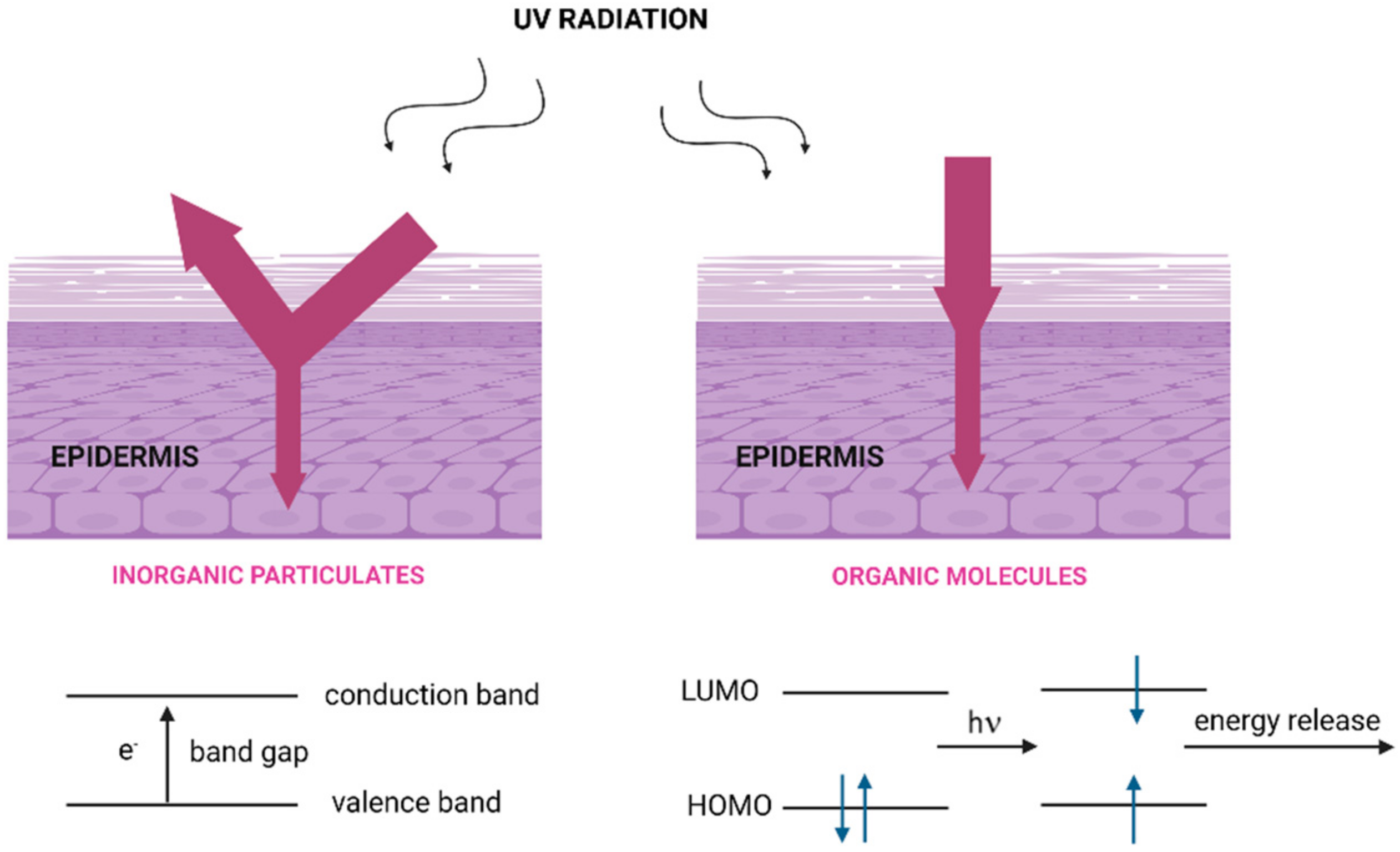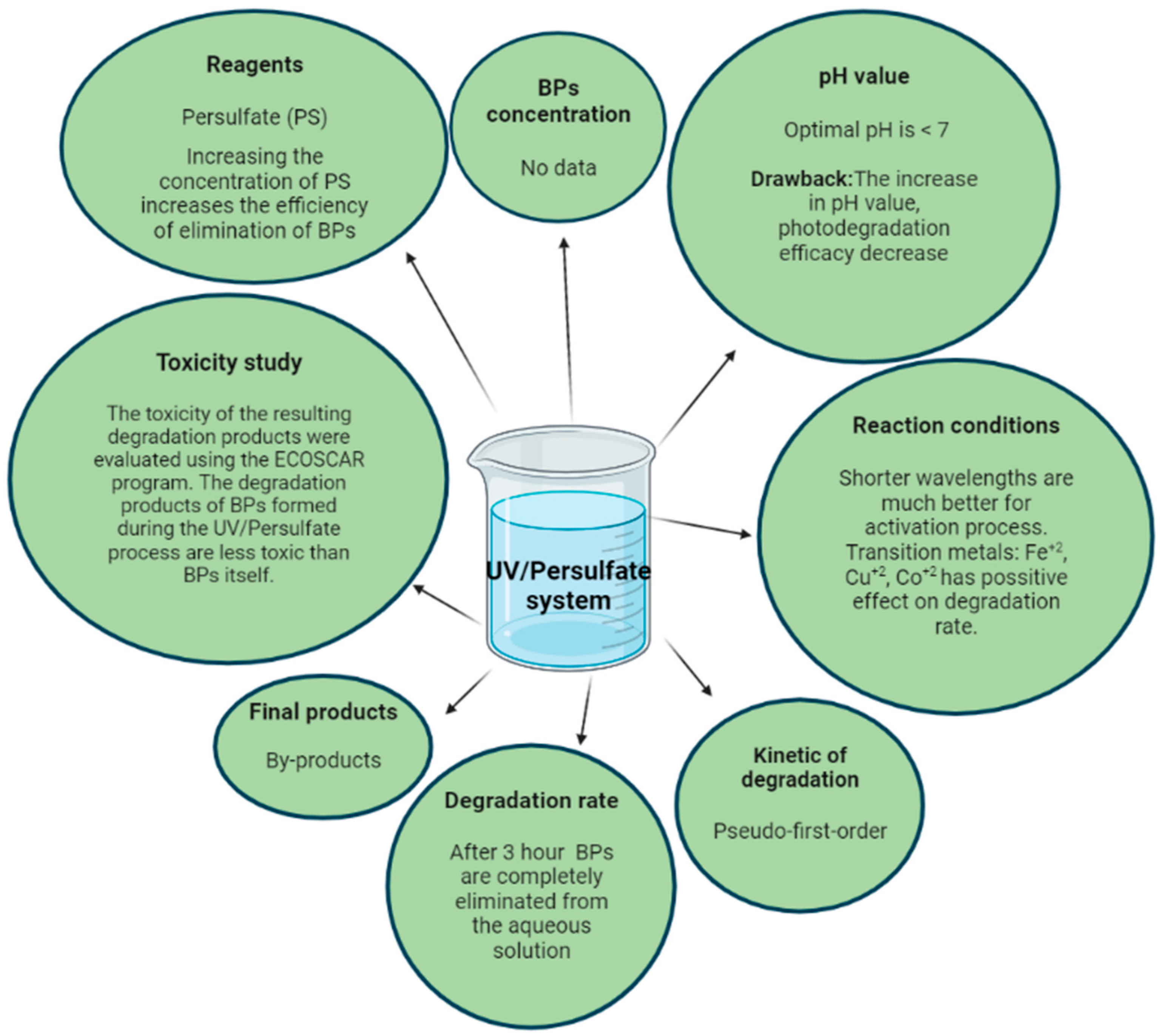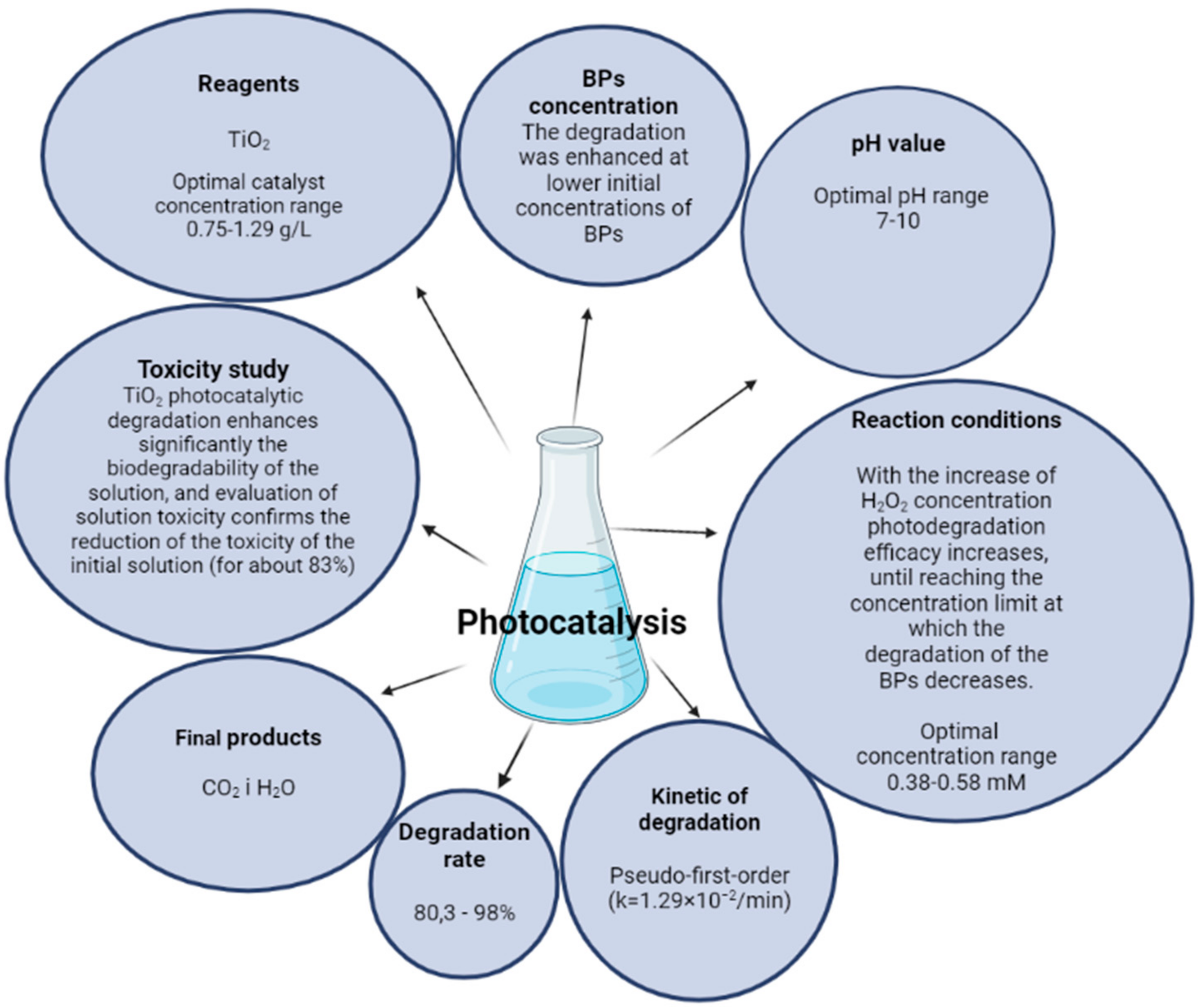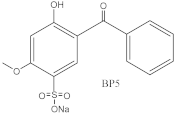Stability and Removal of Benzophenone-Type UV Filters from Water Matrices by Advanced Oxidation Processes
Abstract
:1. Introduction
1.1. Mechanism of UV Absorption
1.2. Benzophenone-Type UV Filters
2. Photodegradation of Benzophenone-Type UV Filters in Aquatic Environments
2.1. Effect of Natural and Artificial UV Radiation on Benzophenone Stability
2.2. Main Pathways of Transformation and Kinetics in Different Waters
2.3. Effect of the Presence of BPs on the Degradation of Other Pollutants
2.4. Photostability of BPs in Swimming Pool Water
2.5. Photostability of BPs in the Presence of Organic Dissolve Matters
3. Degradation of Benzophenone-Type UV Filters Based on Advanced Oxidation Method
3.1. Degradation of Benzophenone Type UV Filters: UV/H2O2 Process
3.2. The Degradation of Benzophenone Type UV Filters: UV/Fenton Process
3.3. The Degradation of Benzophenone Type UV Filters: UV/Persulfate Process
3.4. Application of Nanoparticles for the Photocatalytic Degradation of Benzophenone-Type UV Filters
3.4.1. Fundamentals and Mechanism of TiO2 Photocatalysis
3.4.2. Photocatalytic Degradation of Benzophenone-Type UV Filters
Effect of Catalyst Amount on Photocatalytic Degradation
| Photocatalyst | Pollutant | Optimal Conditions | Degradation Rate | Reference |
|---|---|---|---|---|
| TiO2 nanoparticles coated quartz tubes | BP-3 | pH 10, BP-3 concentration 1 mg/L, 225 cm2 of catalyst surface area, 15 min UVC irradiation | 98% | [71] |
| TiO2 nano-layer on quartz wool (TiO2-qw) | BP-3, BP-4 | pH 7, 8, initial concentrations 5 mg/L, deionized and tap water, catalyst quartz wool, UVC irradiation, 4 h of treatment | >90% in deionized water 70% in tap water | [72] |
| TiO2 (Degussa P-25) | BP-3 | pH 9.0, BP-3 concentration 1 mg/L, TiO2 concentration of 1.184 g/L, and H2O2 concentration of 128.069 mg/L, 30 min UVC irradiation | 91.66% | [72] |
| TiO2 nanowires (TiO2NWs) | BP-4 | pH 5, BP-4 concentration of 20 μM, catalyst concentration 1.2 g/L, 180 min UV irradiation (400–360 nm) | 90% | [73] |
| Cellulose acetate monolithic structures coated with thin films of commercial Fe2O3and TiO2 (P25, PC105, and PC500) nanoparticles with which the photoreactor tube is coated | Ensulizole (PBSA), BP-4 and BP-3 | pH 7, concentration of pollutants: 0.042 µM (PBSA), 0.042 µM (BP-4), 0.051 µM (BP-3), H2O2 of 0.59 mM, 30 min UVA | 44% (PBSA), 90% (BP-4), and 91% (BP-3) | [74] |
| PbO/TiO2-2:1 | BP-3 | pH 7, BP-3 concentration 20 µM, PbO/TiO2-2:1 was 0.75 g/L, 120 min UVC irradiation | 86.6% | [73] |
| Sb2O3/TiO2-2:1 | BP-3 | pH 9, BP-3 concentration 20 µM, Sb2O3/TiO2-2:1 concentration 0.25 g/L, 120 min UVC irradiation | 80.3% | [73] |
Effect of BPs Initial Concetration on Photocatalytic Degradation
Effect of pH on Photocatalytic Degradation
Effect of H2O2 Concentration on Photocatalytic Degradation
Degradation Kinetics
Identification of Intermediaries and Toxicity Studies
Applicability of the Photocatalyst in BPs Removal from Water
4. Conclusions and Future Perspectives
Author Contributions
Funding
Conflicts of Interest
References
- Shaath, N.A. Ultraviolet filters. Photochem. Photobiol. Sci. 2010, 9, 464–469. [Google Scholar] [CrossRef] [PubMed]
- Narayanan, D.L.; Saladi, R.N.; Fox, J.L. Ultraviolet radiation and skin cancer. Int. J. Dermatol. 2010, 49, 978–986. [Google Scholar] [CrossRef] [PubMed]
- Poljšak, B.; Dahmane, R. Free radicals and extrinsic skin aging. Dermatol. Res. Pract. 2012, 2012, 13520. [Google Scholar] [CrossRef] [Green Version]
- Lim, J.; Cho, E.; Lee, K.; Choi, Y.; Seo, Y.; Jeon, H.; Choi, J. Current Immunotherapy Approaches for Malignant Melanoma. BioChip J. 2019, 13, 105–114. [Google Scholar] [CrossRef]
- Giokas, D.L.; Salvador, A.; Chisvert, A. UV filters: From sunscreens to human body and the environment. TrAC-Trends Anal. Chem. 2007, 26, 360–374. [Google Scholar] [CrossRef]
- Silvia Díaz-Cruz, M.; Llorca, M.; Barceló, D. Organic UV filters and their photodegradates, metabolites and disinfection by-products in the aquatic environment. TrAC-Trends Anal. Chem. 2008, 27, 873–887. [Google Scholar] [CrossRef]
- Sobek, A.; Bejgarn, S.; Rudén, C.; Molander, L.; Breitholtz, M. In the shadow of the Cosmetic Directive-Inconsistencies in EU environmental hazard classification requirements for UV-filters. Sci. Total Environ. 2013, 461–462, 706–711. [Google Scholar] [CrossRef]
- Data Europa.Eu. Available online: https://data.europa.eu/data/datasets/cosmetic-ingredient-database-list-of-uv-filters-allowed-in-cosmetic-products?locale=en (accessed on 5 December 2021).
- Sabzevari, N.; Qiblawi, S.; Norton, S.A.; Fivenson, D. Sunscreens: UV filters to protect us: Part 1: Changing regulations and choices for optimal sun protection. Int. J. Women’s Dermatol. 2021, 7, 28–44. [Google Scholar] [CrossRef]
- Kockler, J.; Oelgemöller, M.; Robertson, S.; Glass, B.D. Photostability of sunscreens. J. Photochem. Photobiol. C Photochem. Rev. 2012, 13, 91–110. [Google Scholar] [CrossRef]
- Freitas, J.V.; Lopes, N.P.; Gaspar, L.R. Photostability evaluation of five UV-filters, trans-resveratrol and beta-carotene in sunscreens. Eur. J. Pharm. Sci. 2015, 78, 79–89. [Google Scholar] [CrossRef]
- Gaspar, L.R.; Maia Campos, P.M.B.G. Evaluation of the photostability of different UV filter combinations in a sunscreen. Int. J. Pharm. 2006, 307, 123–128. [Google Scholar] [CrossRef]
- Gaspar, L.R.; Campos, P.M.B.G.M. Photostability and efficacy studies of topical formulations containing UV-filters combination and vitamins A, C and E. Int. J. Pharm. 2007, 343, 181–189. [Google Scholar] [CrossRef]
- Herzog, B.; Wehrle, M.; Quass, K. Photostability of UV absorber systems in sunscreens. Photochem. Photobiol. 2009, 85, 869–878. [Google Scholar] [CrossRef]
- Fent, K.; Zenker, A.; Rapp, M. Widespread occurrence of estrogenic UV-filters in aquatic ecosystems in Switzerland. Environ. Pollut. 2010, 158, 1817–1824. [Google Scholar] [CrossRef]
- Ramos, S.; Homem, V.; Alves, A.; Santos, L. Advances in analytical methods and occurrence of organic UV-filters in the environment-A review. Sci. Total Environ. 2015, 526, 278–311. [Google Scholar] [CrossRef] [Green Version]
- Mao, F.; He, Y.; Gin, K.Y.-H. Occurrence and fate of benzophenone-type UV filters in aquatic environments: A review. Environ. Sci. Water Res. Technol. 2019, 5, 209–223. [Google Scholar] [CrossRef]
- Poiger, T.; Buser, H.R.; Balmer, M.E.; Bergqvist, P.A.; Müller, M.D. Occurrence of UV filter compounds from sunscreens in surface waters: Regional mass balance in two Swiss lakes. Chemosphere 2004, 55, 951–963. [Google Scholar] [CrossRef]
- Kasprzyk-Hordern, B.; Dinsdale, R.M.; Guwy, A.J. Erratum. The removal of pharmaceuticals, personal care products, endocrine disruptors and illicit drugs during wastewater treatment and its impact on the quality of receiving waters. Water Res. 2010, 44, 2076. [Google Scholar] [CrossRef]
- Brausch, J.M.; Rand, G.M. A review of personal care products in the aquatic environment: Environmental concentrations and toxicity. Chemosphere 2011, 82, 1518–1532. [Google Scholar] [CrossRef]
- Ekpeghere, K.I.; Kim, U.-J.; O, S.-H.; Kim, H.-Y.; Oh, J.-E. Distribution and seasonal occurrence of UV filters in rivers and wastewater treatment plants in Korea. Sci. Total Environ. 2016, 542, 121–128. [Google Scholar] [CrossRef]
- Japan Chemical Industry Ecology-Toxicology & Information Center; Japan. Tsūshō Sangyōshō; Chemicals Inspection & Testing Institute (Japan). Biodegradation and Bioaccumulation Data of Existing Chemicals Based on the CSCL Japan; Japan Chemical Industry Ecology-Toxicology & Information Center: Tokyo, Japan, 1992; ISBN 9784890741014. [Google Scholar]
- Ricci, A.; Chrétien, M.N.; Maretti, L.; Scaiano, J.C. TiO2-promoted mineralization of organic sunscreens in water suspension and sodium dodecyl sulfate micelles. Photochem. Photobiol. Sci. 2003, 2, 487–492. [Google Scholar] [CrossRef] [PubMed]
- Rodil, R.; Moeder, M.; Altenburger, R.; Schmitt-Jansen, M. Photostability and phytotoxicity of selected sunscreen agents and their degradation mixtures in water. Anal. Bioanal. Chem. 2009, 395, 1513–1524. [Google Scholar] [CrossRef] [PubMed]
- Vione, D.; Caringella, R.; De Laurentiis, E.; Pazzi, M.; Minero, C. Phototransformation of the sunlight filter benzophenone-3 (2-hydroxy-4-methoxybenzophenone) under conditions relevant to surface waters. Sci. Total Environ. 2013, 463–464, 243–251. [Google Scholar] [CrossRef] [PubMed] [Green Version]
- Li, Y.; Qiao, X.; Zhou, C.; Zhang, Y.N.; Fu, Z.; Chen, J. Photochemical transformation of sunscreen agent benzophenone-3 and its metabolite in surface freshwater and seawater. Chemosphere 2016, 153, 494–499. [Google Scholar] [CrossRef]
- Gago-Ferrero, P.; Badia-Fabregat, M.; Olivares, A.; Piña, B.; Blánquez, P.; Vicent, T.; Caminal, G.; Díaz-Cruz, M.S.; Barceló, D. Evaluation of fungal- and photo-degradation as potential treatments for the removal of sunscreens BP3 and BP1. Sci. Total Environ. 2012, 427–428, 355–363. [Google Scholar] [CrossRef]
- Kotnik, K.; Kosjek, T.; Žegura, B.; Filipič, M.; Heath, E. Photolytic fate and genotoxicity of benzophenone-derived compounds and their photodegradation mixtures in the aqueous environment. Chemosphere 2016, 147, 114–123. [Google Scholar] [CrossRef]
- Liu, Y.S.; Ying, G.G.; Shareef, A.; Kookana, R.S. Photostability of the UV filter benzophenone-3 and its effect on the photodegradation of benzotriazole in water. Environ. Chem. 2011, 8, 581–588. [Google Scholar] [CrossRef]
- Sakkas, V.A.; Giokas, D.L.; Lambropoulou, D.A.; Albanis, T.A. Aqueous photolysis of the sunscreen agent octyl-dimethyl-p-aminobenzoic acid: Formation of disinfection byproducts in chlorinated swimming pool water. J. Chromatogr. A 2003, 1016, 211–222. [Google Scholar] [CrossRef]
- Negreira, N.; Canosa, P.; Rodríguez, I.; Ramil, M.; Rubí, E.; Cela, R. Study of some UV filters stability in chlorinated water and identification of halogenated by-products by gas chromatography-mass spectrometry. J. Chromatogr. A 2008, 1178, 206–214. [Google Scholar] [CrossRef]
- Zhuang, R.; Žabar, R.; Grbović, G.; Dolenc, D.; Yao, J.; Tišler, T.; Trebše, P. Stability and toxicity of selected chlorinated benzophenone-type UV filters in waters. Acta Chim. Slov. 2013, 60, 826–832. [Google Scholar]
- Zhang, T.; Dong, J.; Ji, Y.; Kong, D.; Lu, J. Photodegradation of benzophenones sensitized by nitrite. Sci. Total Environ. 2022, 802, 14985. [Google Scholar] [CrossRef]
- Semones, M.C.; Sharpless, C.M.; MacKay, A.A.; Chin, Y.P. Photodegradation of UV filters oxybenzone and sulisobenzone in wastewater effluent and by dissolved organic matter. Appl. Geochem. 2017, 83, 150–157. [Google Scholar] [CrossRef]
- Gago-Ferrero, P.; Diaz-Cruz, M.S.; Barceló, D. An overview of UV-absorbing compounds (organic UV filters) in aquatic biota. Anal. Bioanal. Chem. 2012, 404, 2597–2610. [Google Scholar] [CrossRef]
- Zhang, S.; Yang, X.; Chen, J.; Wei, X.; Xie, Q.; Wang, Y.; Luo, T. Aquatic environmental photochemical behavior of organic sunscreens. Chin. Sci. Bull. 2013, 58, 2989–3006. [Google Scholar]
- Lu, S.; Long, F.; Lu, P.; Lei, B.; Jiang, Z.; Liu, G.; Zhang, J.; Ma, S.; Yu, Y. Benzophenone-UV filters in personal care products and urine of schoolchildren from Shenzhen, China: Exposure assessment and possible source. Sci. Total Environ. 2018, 640, 1214–1220. [Google Scholar] [CrossRef]
- Ramos, S.; Homem, V.; Alves, A.; Santos, L. A review of organic UV-filters in wastewater treatment plants. Environ. Int. 2016, 86, 24–44. [Google Scholar] [CrossRef]
- Yang, Y.; Ok, Y.S.; Kim, K.H.; Kwon, E.E.; Tsang, Y.F. Occurrences and removal of pharmaceuticals and personal care products (PPCPs) in drinking water and water/sewage treatment plants: A review. Sci. Total Environ. 2017, 596–597, 303–320. [Google Scholar] [CrossRef]
- Tufail, A.; Price, W.E.; Mohseni, M.; Pramanik, B.K.; Hai, F.I. A critical review of advanced oxidation processes for emerging trace organic contaminant degradation: Mechanisms, factors, degradation products, and effluent toxicity. J. Water Process Eng. 2021, 40, 101778. [Google Scholar] [CrossRef]
- Tufail, A.; Price, W.E.; Hai, F.I. A critical review on advanced oxidation processes for the removal of trace organic contaminants: A voyage from individual to integrated processes. Chemosphere 2020, 260, 127460. [Google Scholar] [CrossRef]
- Giannakis, S.; Gamarra Vives, F.A.; Grandjean, D.; Magnet, A.; De Alencastro, L.F.; Pulgarin, C. Effect of advanced oxidation processes on the micropollutants and the effluent organic matter contained in municipal wastewater previously treated by three different secondary methods. Water Res. 2015, 84, 295–306. [Google Scholar] [CrossRef]
- Glauner, T.; Kunz, F.; Zwiener, C.; Frimmel, F.H. Elimination of swimming pool water disinfection by-products with advanced oxidation processes (AOPs). Acta Hydrochim. Hydrobiol. 2005, 33, 585–594. [Google Scholar] [CrossRef]
- De la Cruz, N.; Esquius, L.; Grandjean, D.; Magnet, A.; Tungler, A.; de Alencastro, L.F.; Pulgarín, C. Degradation of emergent contaminants by UV, UV/H2O2 and neutral photo-Fenton at pilot scale in a domestic wastewater treatment plant. Water Res. 2013, 47, 5836–5845. [Google Scholar] [CrossRef]
- Kanakaraju, D.; Glass, B.D.; Oelgemöller, M. Advanced oxidation process-mediated removal of pharmaceuticals from water: A review. J. Environ. Manag. 2018, 219, 189–207. [Google Scholar] [CrossRef]
- Gong, P.; Yuan, H.; Zhai, P.; Xue, Y.; Li, H.; Dong, W.; Mailhot, G. Investigation on the degradation of benzophenone-3 by UV/H2O2 in aqueous solution. Chem. Eng. J. 2015, 277, 97–103. [Google Scholar] [CrossRef]
- Peng, M.; Du, E.; Li, Z.; Li, D.; Li, H. Transformation and toxicity assessment of two UV filters using UV/H2O2 process. Sci. Total Environ. 2017, 603–604, 361–369. [Google Scholar] [CrossRef]
- Du, E.; Li, J.; Zhou, S.; Li, M.; Liu, X.; Li, H. Insight into the degradation of two benzophenone-type UV filters by the UV/H2O2 advanced oxidation process. Water 2018, 10, 1238. [Google Scholar] [CrossRef] [Green Version]
- Mao, F.; He, Y.; Gin, K.Y.-H. Evaluating the Joint Toxicity of Two Benzophenone-Type UV Filters on the Green Alga Chlamydomonas reinhardtii with Response Surface Methodology. Toxics 2018, 6, 8. [Google Scholar] [CrossRef] [Green Version]
- Zúñiga-Benítez, H.; Aristizábal-Ciro, C.; Peñuela, G.A. Photodegradation of the endocrine-disrupting chemicals benzophenone-and methylparaben using Fenton reagent: Optimization of factors and mineralization/biodegradability studies. J. Taiwan Inst. Chem. Eng. 2016, 59, 380–388. [Google Scholar] [CrossRef]
- Zúñiga-Benítez, H.; Peñuela, G.A. Application of solar photo-Fenton for benzophenone-type UV filters removal. J. Environ. Manag. 2018, 217, 929–938. [Google Scholar] [CrossRef]
- American Public Health Association. Standard Methods for the Examination of Water and Wastewater, 22th ed.; American Public Health Association: Washington, DC, USA, 2012. [Google Scholar]
- Sharma, J.; Mishra, I.M.; Kumar, V. Degradation and mineralization of Bisphenol A (BPA) in aqueous solution using advanced oxidation processes: UV/H2O2 and UV/S2O82-oxidation systems. J. Environ. Manag. 2015, 156, 266–275. [Google Scholar] [CrossRef]
- Yang, Q.; Ma, Y.; Chen, F.; Yao, F.; Sun, J.; Wang, S.; Yi, K.; Hou, L.; Li, X.; Wang, D. Recent advances in photo-activated sulfate radical-advanced oxidation process (SR-AOP) for refractory organic pollutants removal in water. Chem. Eng. J. 2019, 378, 122149. [Google Scholar] [CrossRef]
- Tan, C.; Gao, N.; Deng, Y.; Zhang, Y.; Sui, M.; Deng, J.; Zhou, S. Degradation of antipyrine by UV, UV/H2O2 and UV/PS. J. Hazard. Mater. 2013, 260, 1008–1016. [Google Scholar] [CrossRef] [PubMed]
- Lu, X.; Shao, Y.; Gao, N.; Chen, J.; Deng, H.; Chu, W.; An, N.; Peng, F. Investigation of clofibric acid removal by UV/persulfate and UV/chlorine processes: Kinetics and formation of disinfection byproducts during subsequent chlor(am)ination. Chem. Eng. J. 2018, 331, 364–371. [Google Scholar] [CrossRef]
- Zhou, L.; Ferronato, C.; Chovelon, J.M.; Sleiman, M.; Richard, C. Investigations of diatrizoate degradation by photo-activated persulfate. Chem. Eng. J. 2017, 311, 28–36. [Google Scholar] [CrossRef]
- Pan, X.; Yan, L.; Qu, R.; Wang, Z. Degradation of the UV-filter benzophenone-3 in aqueous solution using persulfate activated by heat, metal ions and light. Chemosphere 2018, 196, 95–104. [Google Scholar] [CrossRef]
- Anipsitakis, G.P.; Dionysiou, D.D. Radical generation by the interaction of transition metals with common oxidants. Environ. Sci. Technol. 2004, 38, 3705–3712. [Google Scholar] [CrossRef]
- Feng, M.; Qu, R.; Zhang, X.; Sun, P.; Sui, Y.; Wang, L.; Wang, Z. Degradation of flumequine in aqueous solution by persulfate activated with common methods and polyhydroquinone-coated magnetite/multi-walled carbon nanotubes catalysts. Water Res. 2015, 85, 1–10. [Google Scholar] [CrossRef]
- De Luca, A.; He, X.; Dionysiou, D.D.; Dantas, R.F.; Esplugas, S. Effects of bromide on the degradation of organic contaminants with UV and Fe2+ activated persulfate. Chem. Eng. J. 2017, 318, 206–213. [Google Scholar] [CrossRef]
- Gatermann, R.; Hühnerfuss, H.; Rimkus, G.; Wolf, M.; Franke, S. The distribution of nitrobenzene and other nitroaromatic compounds in the North Sea. Mar. Pollut. Bull. 1995, 30, 221–227. [Google Scholar] [CrossRef]
- Zucchi, S.; Blüthgen, N.; Ieronimo, A.; Fent, K. The UV-absorber benzophenone-4 alters transcripts of genes involved in hormonal pathways in zebrafish (Danio rerio) eleuthero-embryos and adult males. Toxicol. Appl. Pharmacol. 2011, 250, 137–146. [Google Scholar] [CrossRef]
- Doll, T.E.; Frimmel, F.H. Removal of selected persistent organic pollutants by heterogeneous photocatalysis in water. Catal. Today 2005, 101, 195–202. [Google Scholar] [CrossRef]
- Esbenshade, J.L.; Cardoso, J.C.; Zanoni, M.V.B. Removal of sunscreen compounds from swimming pool water using self-organized TiO2 nanotubular array electrodes. J. Photochem. Photobiol. A Chem. 2010, 214, 257–263. [Google Scholar] [CrossRef]
- Wang, R.; Ma, X.; Liu, T.; Li, Y.; Song, L.; Tjong, S.C.; Cao, L.; Wang, W.; Yu, Q.; Wang, Z. Degradation aspects of endocrine disrupting chemicals: A review on photocatalytic processes and photocatalysts. Appl. Catal. A Gen. 2020, 597, 117547. [Google Scholar] [CrossRef]
- Chong, M.N.; Jin, B.; Chow, C.W.K.; Saint, C. Recent Developments in Photocatalytic Water Treatment Technology: A Review. Water Res. 2010, 44, 2997–3027. [Google Scholar] [CrossRef]
- Dong, H.; Zeng, G.; Tang, L.; Fan, C.; Zhang, C.; He, X.; He, Y. An Overview on Limitations of TiO2-Based Particles for Photocatalytic Degradation of Organic Pollutants and the Corresponding Countermeasures. Water Res. 2015, 79, 128–146. [Google Scholar] [CrossRef]
- Joseph, C.G.; Liew, Y.L.S.; Krishnainh, D.; Bono, A. Application of a Semiconductor Oxide-Based Catalyst in Heterogeneous Wasterwater treatment: A Green Technology Approach. J Appl. Sci. 2012, 12, 1966–1971. [Google Scholar] [CrossRef] [Green Version]
- Celeiro, M.; Faccoro, R.; Dagnac, T.; Vilar, V.J.P.; Llompart, M. Photodegradation behaviour of multiclass ultraviolet filters in the aquatic environment: Removal strategies and photoproduct identification by liquid chromatography-high resolution mass spectrometry. J. Chromatogr. A 2019, 1596, 8–19. [Google Scholar] [CrossRef]
- Moradi, N.; Amin, M.M.; Fatehizadeh, A.; Ghasemi, Z. Degradation of UV-Filter Benzophenon-3 in Aqueous Solution Using TiO2 Coated on Quartz Tubes. J. Environ. Heal. Sci. Eng. 2018, 16, 213–228. [Google Scholar] [CrossRef]
- Saracino, M.; Pretali, L.; Capobianco, M.L.; Emmi, S.S.; Navacchia, M.L.; Bezzi, F.; Mingazzini, C.; Burresi, E.; Zanelli, A. Titania Nano-Coated Quartz Wool for the Photocatalytic Mineralisation of Emerging Organic Contaminants. Water Sci. Technol. 2018, 77, 409–416. [Google Scholar] [CrossRef] [Green Version]
- Soto-Vázquez, L.; Rolón-Delgado, F.; Rivera, K.; Cotto, M.C.; Ducongé, J.; Morant, C.; Pinilla, S.; Márquez-Linares, F.M. Catalytic Use of TiO2 Nanowires in the Photodegradation of Benzophenone-4 as an Active Ingredient in Sunscreens. J. Environ. Manag. 2019, 247, 822–828. [Google Scholar] [CrossRef]
- Zúñiga-Benítez, H.; Aristizábal-Ciro, C.; Peñuela, G.A. Heterogeneous Photocatalytic Degradation of the Endocrine-Disrupting Chemical Benzophenone-3: Parameters Optimization and by-Products Identification. J. Environ. Manag. 2016, 167, 246–258. [Google Scholar] [CrossRef]
- Wang, Z.; Deb, A.; Srivastava, V.; Iftekhar, S.; Ambat, I.; Sillanpää, M. Investigation of Textural Properties and Photocatalytic Activity of PbO/TiO2 and Sb2O3/TiO2 towards the Photocatalytic Degradation Benzophenone-3 UV Filter. 2019, 228, 115763. [Google Scholar] [CrossRef]
- Celeiro, M.; Vignola Hackbarth, F.; Selene, S.M.A.G.; Llompart, M.; Vilar, V.J.P. Assessment of advanced oxidation processes for the degradation of three UV filters from swimming pool water. J. Photochem. Photobiol. A Chem. 2018, 351, 95–107. [Google Scholar] [CrossRef]






| Group | Typical Representatives |
|---|---|
| Benzophenone derivatives | Benzophenone-3 (BP3), benzophenone-4 (BP4) |
| p-Aminobenzoic acid and its derivatives (PABA) | Ethylhexyl dimethyl PABA (OD-PABA) |
| Dibenzoylmethane derivatives | 4-tert-Butyl-47-methoxydibenzoylmethane (avobenzone) |
| Salycilates | Homosalate (HMS) |
| Methoxycinnamates | Ethylhexyl methoxycinnamate (OMC) |
| Camphor derivatives | 4-methylbenzylidene camphor (4-MBC) |
| Triazine derivatives | Ethylhexyltriazone (OT) |
| Benzotriazole derivatives | Drometrizole trisiloxane (DRT) |
| Benzoimidazole derivatives | Phenylbenzimidazole sulfonic acid (PMDSA) |
| Others | Octocrylene (OCR) |
| INCI Name 1 | Abbreviation | Structure | Cas No. 2 | Log Kow 2 | Molecular Weight (g/mol) | Water Solubility (mg L−1) 2 |
|---|---|---|---|---|---|---|
| Benzophenone | BP |  | 119-61-9 | 3.18 | 182.22 | 137 |
| Benzophenone-1; 2,4-Dihydroxybenzophenone | BP-1 |  | 131-56-6 | 2.96 | 214.22 | 413.4 |
| Benzophenone-2; 2,2’,4,4’-tetrahydroxybenzophenone | BP-2 |  | 131-55-5 | 2.78 | 246.22 | 399 |
| Benzophenone-3; 2-hydroxy-4-methoxybenzophenone | BP-3 |  | 131-57-7 | 3.79 | 228.24 | 68.56 |
| Benzophenone-4; 2-hydroxy-4-methoxybenzophenone-5-sulfonic acid | BP-4 |  | 4065-45-6 | 0.37 | 308.31 | 2.03 × 104 |
| Benzophenone-5; 2-hydroxy-4-methoxybenzophenone-5-sodium sulfonate | BP-5 |  | 6628-37-1 | −1.42 | 330.28 | No data |
| Benzophenone-8; 2,2′-dihydroxy-4-methoxybenzophenone | BP-8 |  | 131-53-3 | 3.82 | 244.24 | 52.73 |
| Benzophenone-10; 2-hydroxy-4-methoxy-4′-methylbenzophenone | BP-10 |  | 1641-17-4 | 4.07 | 242.27 | 33.03 |
| Benzophenone-9; 2,2′-Dihydroxy-4,4′-dimethoxybenzophenone-5,5′-disulfonic acid disodium salt | BP-9 |  | 76656-36-5 | −2.78 | 476.36 | 8.89 × 105 |
| Benzophenone-12; 2-hydroxy-4-octyloxybenzophenone | BP-12 |  | 1843-05-6 | 6.96 | 326.18 | 0.037 |
| 2-hydroxybenzophenone | 2HB |  | 117-99-7 | 3.52 | 198.22 | 167.5 |
| 3-hydroxybenzophenone | 3HB |  | 13020-57-0 | 2.67 | 198.22 | 896.5 |
| 4-hydroxybenzophenone | 4HB |  | 1137-42-4 | 3.07 | 198.22 | 406 |
| 4,4-Dihydroxybenzophenone | 4HBP |  | 611-99-4 | 2.19 | 214.20 | 1.91 × 103 |
| Diethylamino hydroxybenzoyl hexyl benzoate | DHHB |  | 302776-68-7 | 6.54 | 397.51 | 8.2 × 10-3 |
| 2,3,4-trihydroxybenzophenone | 234THB |  | 1143-72-2 | 2.91 | 230.22 | 381.1 |
| 4-phenylbenzophenone | 4PB |  | 2128-93-0 | 4.91 | 258.314 | 1.36 |
| 2,2′-dihydroxybenzophenone | 2DHB |  | 835-11-0 | 3.74 | 214.217 | 89.69 |
| 2,4,4′-trihydroxybenzophenone | 244THB |  | 1470-79-7 | 2.48 | 230.216 | 837.4 |
Publisher’s Note: MDPI stays neutral with regard to jurisdictional claims in published maps and institutional affiliations. |
© 2022 by the authors. Licensee MDPI, Basel, Switzerland. This article is an open access article distributed under the terms and conditions of the Creative Commons Attribution (CC BY) license (https://creativecommons.org/licenses/by/4.0/).
Share and Cite
Imamović, B.; Trebše, P.; Omeragić, E.; Bečić, E.; Pečet, A.; Dedić, M. Stability and Removal of Benzophenone-Type UV Filters from Water Matrices by Advanced Oxidation Processes. Molecules 2022, 27, 1874. https://doi.org/10.3390/molecules27061874
Imamović B, Trebše P, Omeragić E, Bečić E, Pečet A, Dedić M. Stability and Removal of Benzophenone-Type UV Filters from Water Matrices by Advanced Oxidation Processes. Molecules. 2022; 27(6):1874. https://doi.org/10.3390/molecules27061874
Chicago/Turabian StyleImamović, Belma, Polonca Trebše, Elma Omeragić, Ervina Bečić, Andrej Pečet, and Mirza Dedić. 2022. "Stability and Removal of Benzophenone-Type UV Filters from Water Matrices by Advanced Oxidation Processes" Molecules 27, no. 6: 1874. https://doi.org/10.3390/molecules27061874
APA StyleImamović, B., Trebše, P., Omeragić, E., Bečić, E., Pečet, A., & Dedić, M. (2022). Stability and Removal of Benzophenone-Type UV Filters from Water Matrices by Advanced Oxidation Processes. Molecules, 27(6), 1874. https://doi.org/10.3390/molecules27061874










